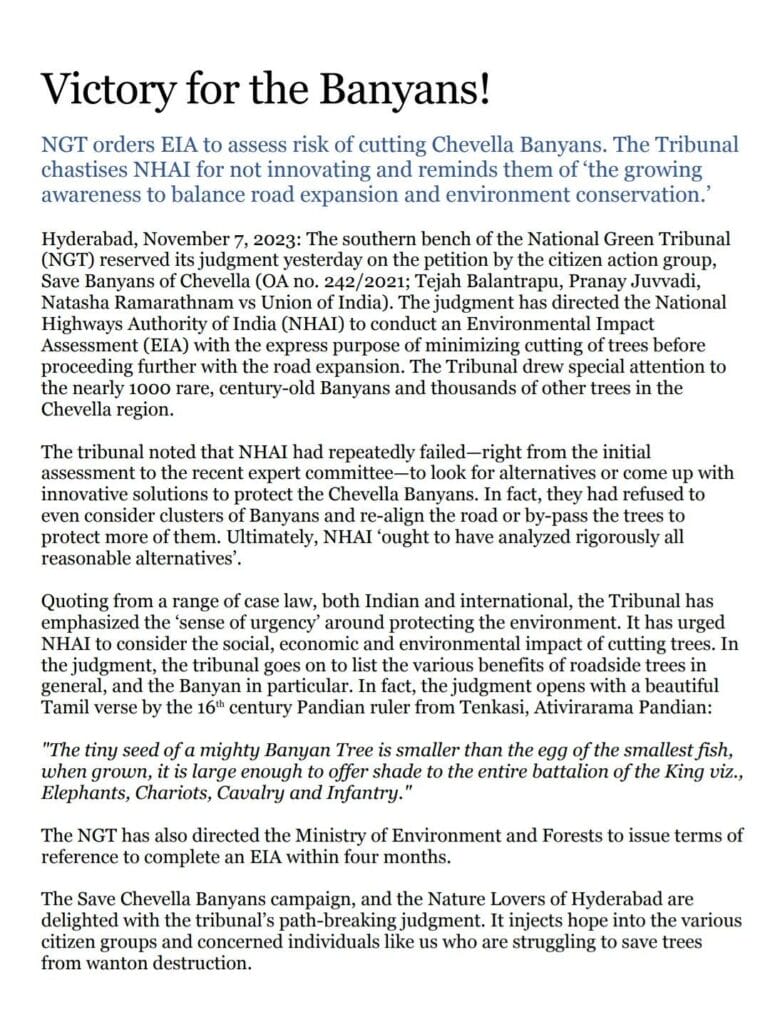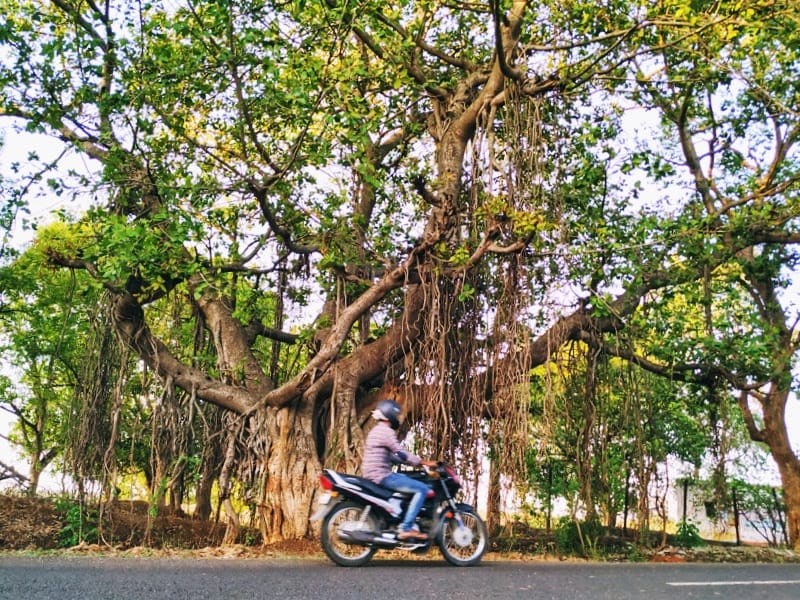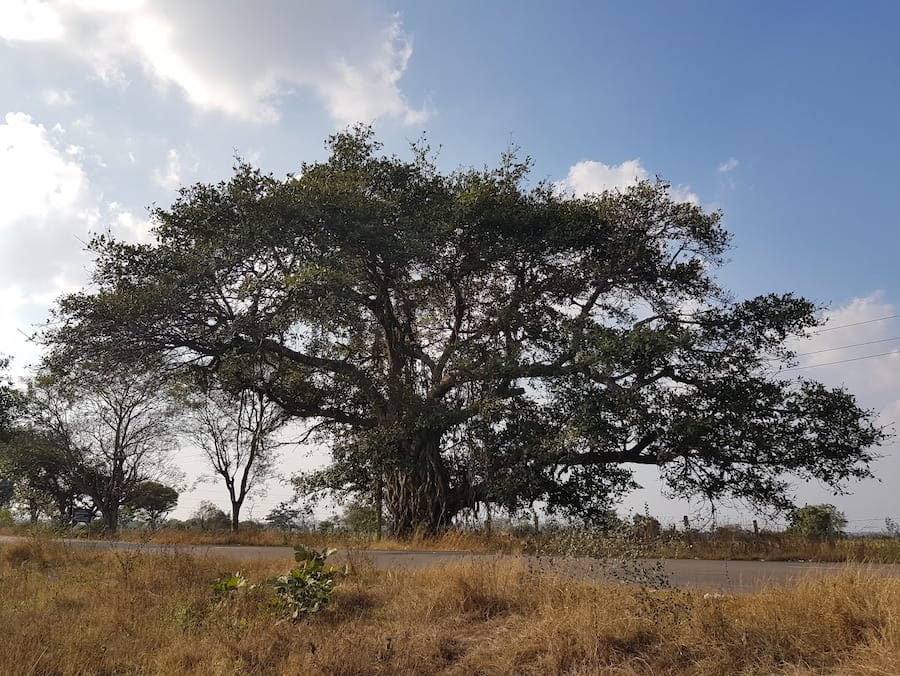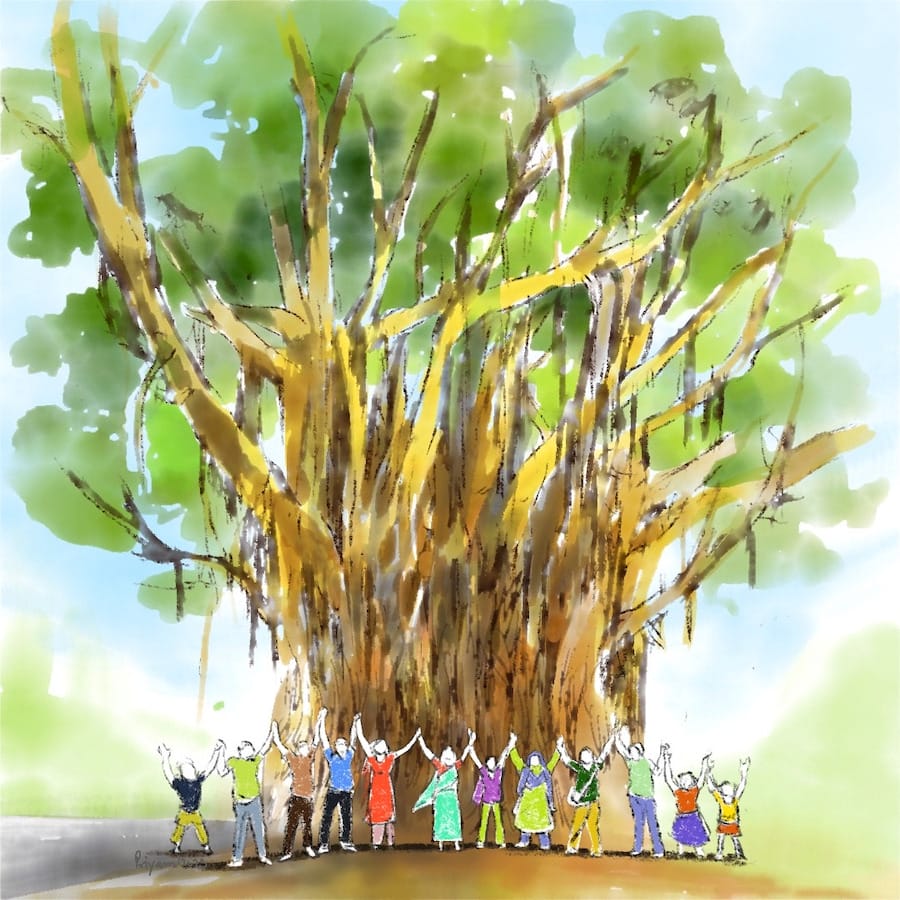When a nature group heard that stately banyan trees, many planted before independence, would be chopped to expand a highway out of Hyderabad, its members pleaded with the National Highways Authority of India (NHAI) to modify the route to spare the trees. When that failed, a small group of citizens went to court, where they called out the NHAI’s false claims about the lack of bird and animal life, the inability to modify the route and the number of trees. How they did it is a lesson for other citizen groups nationwide trying to save roadside trees.
Asiya Khan remembers picnics under them, Sadhna Ramchander remembers motorcycle rides under the great canopies of the banyans of the Chevella road, although she did not remember them as banyans. That could possibly be because all roads out of Hyderabad in those days were lined with trees.
Whether Hyderabad or any other city, highways lined with trees are now vanishingly rare because thousands, if not millions, of trees have been sacrificed for the expansion of these highways nationwide (here, here and here).
A legal victory won on 6 November 2023 by a small group of citizens running a campaign called Save the Chevella Banyans offers a David-vs-Goliath blueprint for citizens who want to make a difference. It also revealed how those building highways and other infrastructure tend not to follow the law, are unwilling to find alternatives and willing to lie to get their way.
“The tiny seed of a mighty Banyan Tree is smaller than the egg of the smallest fish, when grown, it is large enough to offer shade to the entire battalion of the King viz., Elephants, Chariots, Cavalry and Infantry.”
With that translated Tamil quotation from Ativeerarama Pandian, a 16th century Pandian king from Tenkasi, Justice Pushpa Sathyanarayana of the southern bench of the National Green Tribunal (NGT) on 6 November 2023 stopped the National Highways Authority of India (NHAI) from cutting more than 900 banyan trees, many planted before independence, from a highway leading out of Hyderabad, before an environmental assessment of what precisely was at stake. Other trees too received a reprieve, about 13,000 of them, although no one is sure how many precisely.
Read more: When yellow trees disappeared overnight in the ‘green city’ of Hyderabad
A small, rare moment of triumph
To citizens nationwide who have watched the cutting of trees—with no regard for the letter and spirit of the law—the judgement that saved the banyans on the Chevella road, as it is called, was a small, rare but significant moment of triumph.
The judgement is significant because while there are still some protections for trees in a forest—although a new amendment to India’s 43-year-old Forest Conservation Act – 1980 will end most of them, as Article 14 reported in June—there are virtually none available to roadside trees. Thousands have been cut, but thousands still remain.
The most important case that could be made for the Chevella trees—quite apart from their beauty and ecological importance—and the others facing decimation in India’s cities and towns, is that they perform a crucial cooling and carbon-storage function at a time when the Earth is living through what is likely to be the hottest year on record.
Cutting down trees along highways sparks a rise in pollutants and gases contributing to climate change, as this 2021 study of trees cut outside Coimbatore, Tamil Nadu, over four years revealed.
October was the fifth straight month of record monthly heat. Scientists warn that planetary systems may be on the verge of multiple tipping points from global warming. As that happens, India faces a rising number of extreme weather events, with progress and development predicted to slow from rising heat.
“Since the amount of carbon sequestered by a tree is directly proportional to its size, each of these banyans is in George Monbiot’s words ‘a magic machine that sucks carbon out of the air builds itself up and costs very little,’” said a statement by the Save The Chevella Banyans campaign. “That is the most direct case that can be made for retaining the trees in situ.”
The only thing in common: A love for trees
The judgement is significant because it was made possible by a group of citizens who had no political influence and fought a legal battle driven only by a conviction that if they did not do this no one would. “The only thing we had in common was love for trees and the desire to do something to save them,” said Natasha Ramarathnam, one of the group and a petitioner in the case.
With a median age of 50 plus, the Save the Banyans of Chevella campaign was run by a core group of 15 to 20 volunteers, including two professors, two advertising professionals, two 12-standard students, a museum curator, communications professionals and a graphic designer.
Represented in the NGT by Yogeshwaran Amarneeti, a Chennai lawyer, the group, which went to court only after the NHAI refused to even consider alternatives, spent about Rs 1.5 lakh on the case, a “shoestring budget”, with volunteers contributing whatever they could when it was required.
“Our financing model was: if someone said, ‘I’d like to help, and I’d like to donate’, we said wait until we needed it,” said Ramarathnam, 52, who has worked in the development sector, especially with youth from marginalised communities. Only three of the group were named in the public interest litigation. The larger group contributed money when needed.
For example, one person paid Rs 50,000 for drone footage, which refuted an NHAI claim that the highway’s alignment could not change because of the dense forests on either side of the road. The drone showed the NGT that most of the land was barren, with sporadic farmland,
The heady feeling of victory was evident on social media and elsewhere.

“The stay indicates we can do it,” said Ramarathnam. “It’s about these 900 trees and what they mean. All is not lost. There are still good [judges] who will give us good judgments.”
The caste system among trees
Given recent judicial history on ecological issues and general hostility to them, Ramarathnam said, they were “pretty sure the decision would go against us”. Environmental laws in India were not in their favour, she said, because they are not punitive.
“[The laws] say you should not do this, but there is nothing more than a fine, especially for roadside trees (that are cut),” she said. “You have to be a tree in a forest, a tree in a reserve forest or a very old tree in an urban forest (for the laws to apply). There is a caste system even among trees.”
These citizens were not, as they and their petition emphasise, against the widening of the highway. They only opposed the fact that no effort was made to save the grand banyans, and no alternatives were even considered. In doing so, they called out the NHAI’s plan—or the lack of it—to expand a two-lane highway to four-lane by either bending the truth or withholding it in court, a tactic commonly used by agencies or companies that build roads, dams and factories.

What worked: Lawyer, data, luck
Three things worked for them, according to Ramarathnam. “We had an extremely good lawyer, we had data, and we had a lot of luck,” she said.
The data certainly helped. For instance, the NHAI said there were 700 banyans. The group counted 914—they walked the 42-km stretch of the Chellava road, officially called national highway (NH) 163, over four days, in Telangana’s unforgiving sun, photographing and gathering latitude and longitude data for each tree using a GPS app locator (a process called geotagging), estimating height and girth of each tree and creating an excel spreadsheet.
It was clear in court that the NHAI had no competing data. The NHAI said only a “minimum” number of trees would be cut, but they could not say how many. The group could even inform the court that 60% of the trees had a girth of over 5 ft and many exceeded 10 ft.
The NHAI said there were no birds in the banyans—otherwise known as havens for avian and other life—because of “vibrations” from passing vehicles. The group counted 26 species, including two that were endangered, apart from bats, flying foxes, monkeys and more.
The group’s main argument was that the project was not so much an expansion but a new highway. Originally built before independence by the Nizam’s administration, which planted many of the trees, the road was a state highway and not built to specifications of the Indian Road Congress, a technical group of road engineers that lays down road-building standards. What the NHAI proposed was an entirely new highway, the group argued, and that should require a plan and data.

Fighting the loopholes
Expanding a road to a national highway required an environmental impact assessment (EIA) to assess damage and suggest mitigation measures, according to the Environment (Protection) Act, 1986, the group argued.
But modifications made to the law in 2006 and 2013 exempted highway projects from EIAs, if they were less than 100 km in length or had a width of less than 40 m. Most highway projects are now broken up into parcels below the 100-km limit, so no EIAs are required. That is what happened with the banyans. The 42-km stretch is part of a national highway project that will run more than 300 km to Bijapur.
If not done carefully, the group noted, such highway projects could disrupt water channels, break up forests or destroy local ecologies in myriad ways. This is what has happened time after time across India. (here, here and here)
The Chevella banyans have been saved because they were linked to the lives and memories of citizens. In most cases, such trees are not or those affected do not know what to do: there are too many battles to be fought. So, agencies can lie and get away with it. For instance, Bengaluru’s 65-km-long peripheral ring road, if built, will require more than 30,000 trees to be cut.
But this figure emerged in a new EIA that the NGT ordered, after the old one claimed only 200 trees would be chopped. The case was filed by environmental groups who knew the Bangalore Development Authority (BDA), the implementing agency, was lying, as was the original EIA .
Yet, the State took the case to the Supreme Court, which dismissed these claims and concurred that the BDA was “hiding significant components of the environment from scrutiny”. In plain language, the government had indeed lied, not just to citizens but to the court.
Read more: Is the axing of 5,000 trees for road widening around Bengaluru justified?
No intention to stop the highway
As the Save the Chevella Banyan group pointed out, their victory does not mean the expansion of NH-163 will stop—nor do they want it to. But it must be done with a clear assessment of the landscape, accounting for the trees, water bodies and wildlife, they said.
The judgement expanded and reiterated jurisprudence around the faltering effort to save India’s trees. It was in 2004 that the Supreme Court said no trees should be cut for roads in environmentally sensitive areas. That judgement, of course, has been ignored, as successive governments have found or created loopholes that have decimated trees in precisely such areas.
The Supreme Court then had emphasised that alternatives must be explored, which the NHAI did not do for the Chevella road. The NGT judgement this week referred to the 2004 judgement and others like it, both nationally and internationally, referring to the extensive damage that road projects can cause if they are not done with caution.
“Luckily we got a judge who understood the value of trees,” said Ramarathnam. It also helped, she added, that the NHAI refused to discuss the issue, compromise or back down, even refusing a suggestion to cut smaller trees and let the larger ones be. The petitioners expect the NHAI to file an appeal, and they are girding for a new battle.
The Chevella-Banyans judgement may help rethink how India builds its highways, urging a re-evaluation of what it means to cut down trees in the thousands in a time of global warming.
The judgement also reminded the State of the importance of the rule of law, and it reminded citizens that they could, still, force the State to follow these laws.
[This story was first published on Article 14 and has been republished with permission. The original article can be read here]
